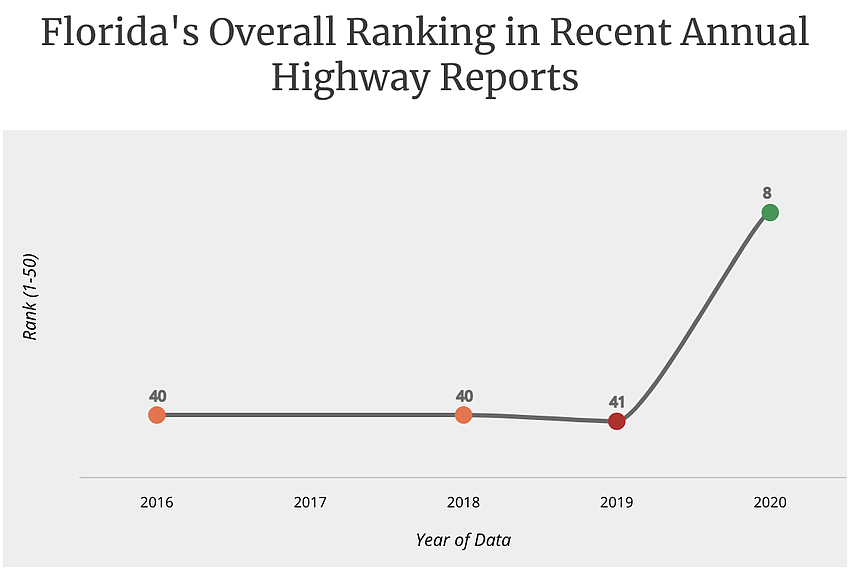- July 18, 2025
-
-
Loading

Every year, the Reason Foundation ranks all 50 states’ highway systems. In this year’s report, examining 2020 data, the latest available, Florida’s highway system ranks eighth in the nation.
That is great, considering how important our roadways are to our economy, including tourism; to our own ability to get around and enjoy our quality of life; and to our ability to evacuate in the event of a hurricane.
Reason’s “Annual Highway Report” uses a broad range of performance measures on the condition and cost-effectiveness of state-controlled highways in 13 categories, including pavement condition, traffic congestion, structurally deficient bridges, traffic fatalities and spending (capital, maintenance, administrative, other) per mile. You can see Florida’s ranking on each of these categories in the accompanying table.
On most of the performance metrics in the table Florida either excels or struggles.
Compared to nearby states, Florida’s overall highway performance is worse than South Carolina (sixth) and Georgia (fourth), but better than Alabama (15th).
Florida ranks ahead of other comparable states, such as Texas (19th) and California (47th).
Florida’s best ranking is in rural Interstate pavement condition. The state does a crackerjack job of maintaining Interstate 75, Interstate 95 and Interstate 10 and others in those long woody stretches between cities. And I think anyone who drives around Florida and other states knows this. Our rural freeways are smooth and lovely rides.
Once those interstates get into urban areas, though, they are not in quite such good shape (ninth), but still pretty good.

Florida also does well on rural arterial pavement (second). These are all the rural highways like the U.S. 41, U.S. 301 and State Road 70, which are in great shape and provide vital links to most interior cities and towns and many coastal ones.
Those same roads in urban areas (urban principal arterials) are also in good shape (fourth).
Finally, Florida ranks eighth in structurally deficient bridges, which is not bad. These are bridges that score as “deficient” on federally mandated inspections of structural adequacy and thus qualify for federal funding to repair them.
Florida has a lot of bridges, given the extent of our wetlands, so this metric is vital to the overall health of the highway network.
The Florida Department of Transportation is at its best in maintaining our state highway system, with good road conditions driving all its top performance categories in the report.
Where the state’s highway system doesn’t rank so well is in safety and cost effectiveness.
Florida’s worst rankings are in urban fatality rate (49th) and rural fatality rate (45th). The state’s rural fatality rate is 2.2 times higher than peer state Pennsylvania and 1.2 times higher than Texas. In urban fatalities, Florida is 1.5 times higher than Pennsylvania and 1.4 times higher than Texas.
Nationwide, both rural and urban roadway fatality rates increased in 2020, with distracted driving being blamed the most.
The Florida Department of Highway Safety and Motor Vehicles data show distracted driving, speeding and driving under the influence are the primary causes of road fatalities.
To be fair, there is no evidence that Florida builds or operates its roads in a way that increases fatalities. The causes are behavior of individuals and cultural problems over which the state highway department has little influence.
Nevertheless, the state is making major efforts to reduce all these causes.

Florida tends to spend more than average on its roads, and that creates poor performance rankings on cost effectiveness. On a per-lane-mile basis, the state ranks 43rd in construction and bridge spending; 29th on maintenance spending; and 28th on administrative spending. All are ranked per lane mile to make fair comparison with other states. For example, Florida’s construction and bridge disbursement per lane mile is 1.5 times higher than Pennsylvania and 1.2 times higher than Texas.
In other words, Florida’s highway system is in better shape than most other states, but we spend more to achieve that performance.
Florida’s highway system is in great shape, and that helps the state rank in the top 10 in the nation on highway performance. That is valuable to our state economy and to our quality of life.
To improve the state’s rankings, we need to find ways to tackle problem drivers that make our road fatality rate among the highest in the nation. Also, finding ways to be more cost effective, such as more use of public-private partnerships, could really improve the state rankings on spending.